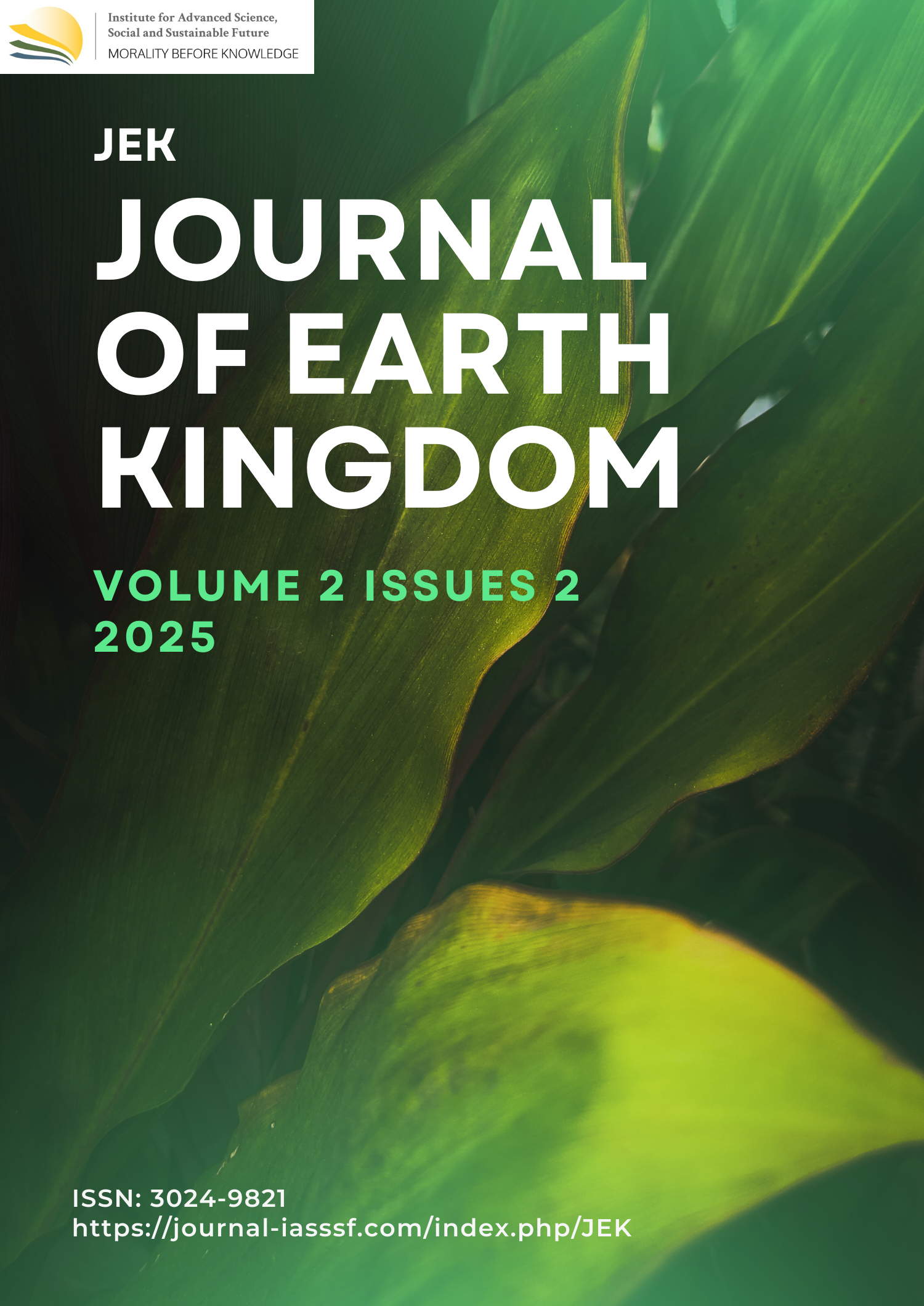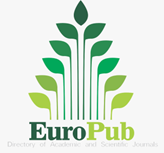Community structure of Crabs (Crustacea: Decapoda): Response to vegetation variation and environmental parameters in mangrove ecosystems
DOI:
https://doi.org/10.61511/jek.v2i2.2025.1440Keywords:
mangrove, diversity, crab community, environmental parameters, ecosystemAbstract
Background: Mangrove ecosystems are crucial for maintaining biodiversity, including crab communities, which are vital to the stability of these ecosystems. Crabs contribute to nutrient cycling and the food web, reinforcing the overall ecological health of coastal habitats. This study focuses on the crab communities in the mangrove area of Tabongo Village, Dulupi District, Boalemo Regency, examining how environmental conditions affect their distribution and diversity. Methods: The research involved surveys at three stations representing different mangrove vegetation conditions. Crab species were identified and their diversity and abundance recorded. Environmental parameters, such as temperature, salinity, and pH, were measured, and the diversity index (H') was calculated to assess species diversity and the relationship between crab communities and environmental factors. Findings: A total of 11 crab species from 4 families were identified, including Uca (Paraleptuca) annulipes and Ocypode ceratophthalmus. The diversity index ranged from 1.3 to 1.6, indicating moderate diversity. Environmental conditions, with temperatures between 32–34 °C, salinity from 13–19 ppt, and pH from 6.5 to 7, were conducive to crab survival. Station III, with healthier mangrove vegetation, supported greater crab diversity and abundance compared to degraded stations. Conclusion: The study highlights the crucial role of healthy mangrove ecosystems in sustaining crab biodiversity and ecosystem stability. It underscores the importance of mangrove conservation for maintaining biodiversity and protecting coastal ecosystems from degradation. Novelty/Originality of this article: By linking the health of mangrove ecosystems to crab diversity and abundance, it emphasizes the direct impact of environmental factors on crab populations. The findings highlight the importance of mangrove conservation not only for species richness but also for maintaining the ecological balance in coastal ecosystems, offering valuable data for future biodiversity management and conservation efforts.
References
Amin, F., Paransa, D. S. J., Ompi, M., Mantiri, D. M., Boneka, F. B., & Kalesaran, O. (2021). Identifikasi morfologi dan keanekaragaman kepiting pada timbunan berbatu di pantai pesisir Malalayang Dua Kota Manado. Jurnal Pesisir dan Laut Tropis, 9(3), 123–132. https://doi.org/10.35800/jplt.9.3.2021.37746
Anggraeni, P., Elfidasari, D., & Pratiwi, R. (2015). Brachyuran crab distribution in Tikus Island, Pari Island Group, Seribu Islands. Prosiding Seminar Nasional Masyarakat Biodiversitas Indonesia, 1(2), 213–221. https://doi.org/10.13057/psnmbi/m010208
Barnes, R. S. K. (2010). A remarkable case of fiddler crab, Uca spp., alpha diversity in Wallacea. Hydrobiologia, 637, 249–253. https://doi.org/10.1007/s10750-009-0007-3
Barua, A., Afrin, T., Akhand, A. A., & Ahmed, M. S. (2021). Molecular Characterization And Phylogenetic Analysis Of Crabs (Crustacea: Decapoda: Brachyura) Based On Mitochondrial Coi And 16s Rrna Genes. Conservation Genetics Resources, 13(3), 291–301. https://doi.org/10.1007/S12686-021-01212-9
Carlson, R. R., Evans, L. J., Foo, S. A., Grady, B. W., Li, J., Seeley, M., Xu, Y., & Asner, G. P. (2021). Synergistic benefits of conserving land-sea ecosystems. Global Ecology and Conservation, 28, e01684. https://doi.org/10.1016/j.gecco.2021.e01684
Crane. (1975). Fiddler Crabs Of The World, Ocypoddae: Genus Uca. Princeton University Press Princeton.
Djamadi, D. A., Faqih, A., Sm, F., & Safitri, I. (2024). Analisis Struktur Vegetasi Hutan Mangrove di Pesisir Tabongo Kecamatan Dulupi Kabupaten Boalemo. Journal of Marine Research, 13(2), 319–327. https://doi.org/10.14710/jmr.v13i2.42138
Eprilurahman, R., Baskoro, W. T., & T, T. (2015). Keanekaragaman jenis kepiting (Decapoda: Brachyura) di Sungai Opak, Daerah Istimewa Yogyakarta. Biogenesis: Jurnal Ilmu Biologi, 3(2). https://doi.org/10.24252/bio.v3i2.934
Faqih, A., & Juramang, R. R. (2023). Keanekaragaman Dan Kelimpahan Jenis Crustacea Di Kawasan Hutan Mangrove Pesisir Langala Kecamatan Dulupi Kabupaten Boalemo. Jambura Edu Biosfer Journal, 5(2), 65–71. https://doi.org/10.34312/Jebj.V5i2.22077
Fazhan, H., Waiho, K., Quinitio, E., Baylon, J. C., Fujaya, Y., Rukminasari, N., Azri, M. F. D., Shahreza, M. S., Ma, H., & Ikhwanuddin, M. (2020). Morphological Descriptions And Morphometric Discriminant Function Analysis Reveal An Additional Four Groups Of Scylla Spp. Peerj, (1). https://doi.org/10.7717/Peerj.8066
Jacobs, R., Kusen, J., Sondak, C., Boneka, F., Warouw, V., & Mingkid, W. (2019). Struktur Komunitas Ekosistem Mangrove Dan Kepiting Bakau Di Desa Lamanggo dan Desa Tope, Kecamatan Biaro, Kabupaten Kepulauan Siau, Tagulandang, Biaro. Jurnal Pesisir Dan Laut Tropis, 7(1), 20. https://doi.org/10.35800/Jplt.7.1.2019.22817
Kamal, E., Yuspardianto, Wulandari, D. P., Fitriyani, & Lubis, A. S. (2024). Biodiversity of Mangrove Brachyuran Crabs Of Family Ocypodidae and Sesarmidae in Koto Xi Tarusan District, West Sumatera, Indonesia. Hayati Journal Of Biosciences, 31(3), 507–516. https://doi.org/10.4308/Hjb.31.3.507-516
Katili, A. S., Utina, R., & Mopangga, N. L. (2017). Short Communication: Crab Species Distribution Under Mangrove Stands In Tabongo, Gorontalo Province, Indonesia. Biodiversitas, 18(2), 520–524. https://doi.org/10.13057/biodiv/d180211
Kristensen, E. (2008). Mangrove Crabs As Ecosystem Engineers; With Emphasis On Sediment Processes. Journal Of Sea Research, 59(1–2), 30–43. https://doi.org/10.1016/J.Seares.2007.05.004
Kasry, A. (1996). Budidaya Kepiting Bakau dan Biologi Ringkas. Bhratara.
Lapolo, N., Utina, R., & Baderan, D. W. K. (2018). Diversity and Density of Crabs in Degraded Mangrove Area at Tanjung Panjang Nature Reserve in Gorontalo, Indonesia. Biodiversitas, 19(3), 1154–1159. https://doi.org/10.13057/Biodiv/D190351
Leviton, J. S. (1982). Marine Biology. Prentice Hall Inc.
Magurran, A. E. (2004). Measuring Biological Diversity. Blackwell Publishing.
Nagelkerken, I., Blaber, S. J. M., Bouillon, S., Green, P., Haywood, M., Kirton, L. G., Meynecke, J.-O., Pawlik, J., Penrose, H. M., Sasekumar, A., & Somerfield, P. J. (2008). The habitat function of mangroves for terrestrial and marine fauna: A review. Aquatic Botany, 89(2), 155–185. https://doi.org/10.1016/j.aquabot.2007.12.007
Pratiwi, R., & Astuti, O. (2012). Biodiversity Of Crustacean (Decapoda, Brachyura, Macrura) From Kendari Waters Expedition 2011. Ilmu Kelautan: Indonesian Journal Of Marine Sciences, 17(1), 8. https://doi.org/10.14710/Ik.Ijms.17.1.8-14
Odum, E. P. (1971). Fundamentals Of Ecology. W.B. Saunders Company.
Rahim, S., & Baderan, D. W. K. (2019). Komposisi Jenis, Struktur Komunitas, Dan Keanekaragaman Mangrove Asosiasi Langge Kabupaten Gorontalo Utara-Provinsi Gorontalo. Jurnal Ilmu Lingkungan, 17(1), 181. Https://doi.org/10.14710/Jil.17.1.181-188
Shannon, C. E., & Wiener, W. (1963). The Mathematical Theory of Communication (127 p). University of Illinois Press.
Sharifian, S., Kamrani, E., & Saeedi, H. (2020). Global biodiversity and biogeography of mangrove crabs: Temperature, the key driver of latitudinal gradients of species richness. Journal of Thermal Biology, 92, 102692. https://doi.org/10.1016/j.jtherbio.2020.102692
Sharifian, S., Kamrani, E., & Saeedi, H. (2021). Global future distributions of mangrove crabs in response to climate change. Wetlands, 41, 99. https://doi.org/10.1007/s13157-021-01503-9
Tarumasely, T., Soselia, F., & Tuhumury, A. (2022). Habitat and population of mangrove crab (Scylla serrata) in mangrove forest in teluk ambon baguala district. Jurnal Hutan Pulau Pulau Kecil, 6(2), 177–182. https://doi.org/10.30598/jhppk.v6i2.7352
Thasya, R., Irwan Nurdiansyah, S., & Arief Nurrahaman, Y. (2023). Community Structure of Mud Crab in Mangrove Area of Desa Sungai Nibung, Kubu Raya Regency, West Kalimantan. Jurnal Laut Khatulistiwa, 6(2). http://Jurnal.Untan.Ac.Id/Index.Php/Lk
Tongununui, P., Kuriya, Y., Murata, M., Sawada, H., Araki, M., Nomura, M., Morioka, K., Ichie, T., Ikejima, K., & Adachi, K. (2021). Mangrove crab intestine and habitat sediment microbiomes cooperatively work on carbon and nitrogen cycling. PloS one, 16(12), e0261654. https://doi.org/10.1371/journal.pone.0261654
Ummah, M. S. (2015). Kepiting Uca Di Hutan Mangrove Indonesia Tinjauan Aspek Biologi Dan Ekologi Untuk Eksplorasi. BRIN (Badan Riset dan Inovasi Nasional).
Wally, W. M., Matdoan, M. N., & Arini, I. (2020). Keanekaragaman dan Pola Distribusi Jenis Kepiting Bakau (Scylla Sp) Pada Zona Intertidal Pantai Dusun Wael Kabupaten Seram Bagian Barat. Biopendix: Jurnal Biologi, Pendidikan dan Terapan, 6(2), 117–120. https://doi.org/10.30598/Biopendixvol6issue2page117-120
Xie, T., Wang, A., Li, S., Cui, B., Bai, J., & Shao, D. (2022). Crab contributions as an ecosystem engineer to sediment turnover in the Yellow River Delta. Frontiers in Marine Science, 9, 1019176. https://doi.org/10.3389/fmars.2022.1019176
Downloads
Published
How to Cite
Issue
Section
Citation Check
License
Copyright (c) 2025 Putri Liani Aliwu, Dewi Wahyuni K. Baderan, Regina Valentina Aydalina, Zuliyanto Zakaria, Marini Susanti Hamidun

This work is licensed under a Creative Commons Attribution 4.0 International License.
















